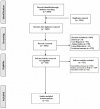Cerebral Blood Flow in Alzheimer's Disease: A Meta-Analysis on Transcranial Doppler Investigations
- PMID: 38804315
- PMCID: PMC11130854
- DOI: 10.3390/geriatrics9030058
Cerebral Blood Flow in Alzheimer's Disease: A Meta-Analysis on Transcranial Doppler Investigations
Abstract
Background: Cerebrovascular hemodynamic impairment has been reported in Alzheimer's disease (AD). We performed a systematic review and meta-analysis to investigate changes in cerebral blood flow (CBF) in AD patients.
Methods: Data were obtained by searching MEDLINE and Scopus for all investigations published between 1 January 2011 and 1 November 2021, comparing the cerebrovascular hemodynamic between AD patients and cognately healthy age-matched controls, using transcranial Doppler (TCD) ultrasound.
Results: Twelve studies, based on 685 patients [395 with AD and 290 age-matched cognitively healthy controls, with a mean age of 71.5 and 72.1 years, respectively] were included in the analysis. A random effect model revealed that AD patients, in the proximal segments of the middle cerebral artery (MCA), have a significantly lower CBF velocity, compared to controls (MD: -7.80 cm/s, 95%CI: -10.78 to -5.13, p < 0.0001, I2 = 71.0%). Due to a significant Egger's test (t = 3.12, p = 0.008), a trim-and-fill analysis was performed, confirming the difference (MD: -11.05 cm/s, 95%CI: -12.28 to -9.82, p < 0.0001). Meta-regression analysis demonstrated that the mean CBF at the proximal MCA was directly correlated with arterial hypertension (p = 0.03) and MMSE score (p < 0.001), but inversely correlated with age (p = 0.01). In AD patients, the pulsatility index was significantly higher compared to controls (MD: 0.16, 95%CI: 0.07 to 0.25, p < 0.0001, I2: 84.5%), while the breath-holding index test results were significant lower (MD: -1.72, 95%CI: -2.53 to -0.91, p < 0.001, I2: 85.4%).
Conclusions: AD patients have a significant impairment in relation to their cerebrovascular perfusion, suggesting that cerebrovascular hemodynamic deterioration, evaluated using TCD, may be a useful diagnostic tool.
Keywords: Alzheimer’s Disease; cerebral flow; transcranial Doppler.
Conflict of interest statement
The authors declare no conflicts of interest.
Figures




Similar articles
-
Reduced Cerebrovascular Reserve Capacity as a Biomarker of Microangiopathy in Alzheimer's Disease and Mild Cognitive Impairment.J Alzheimers Dis. 2018;63(2):465-477. doi: 10.3233/JAD-170815. J Alzheimers Dis. 2018. PMID: 29614647
-
Cerebrovascular Hemodynamics on Transcranial Doppler Ultrasonography and Cognitive Decline in Mild Cognitive Impairment.J Alzheimers Dis. 2018;65(2):651-657. doi: 10.3233/JAD-180026. J Alzheimers Dis. 2018. PMID: 30103317
-
The correlation between cerebral arterial pulsatility and cognitive dysfunction in Alzheimer's disease patients.J Neurol Sci. 2017 Feb 15;373:285-288. doi: 10.1016/j.jns.2017.01.001. Epub 2017 Jan 4. J Neurol Sci. 2017. PMID: 28131207
-
Cerebrovascular hemodynamics in Alzheimer's disease and vascular dementia: a meta-analysis of transcranial Doppler studies.Ageing Res Rev. 2012 Apr;11(2):271-7. doi: 10.1016/j.arr.2011.12.009. Epub 2011 Dec 27. Ageing Res Rev. 2012. PMID: 22226802 Review.
-
Utility of transcranial ultrasound in predicting Alzheimer's disease risk.J Alzheimers Dis. 2014;42 Suppl 4:S365-74. doi: 10.3233/JAD-141803. J Alzheimers Dis. 2014. PMID: 25298200 Review.
Cited by
-
Gadolinium based contrast agent induced electrical conductivity heterogeneity analysis in the brain of Alzheimer's disease.Sci Rep. 2025 Mar 28;15(1):10832. doi: 10.1038/s41598-025-92966-x. Sci Rep. 2025. PMID: 40155644 Free PMC article.
-
The U.S. POINTER neurovascular ancillary study: Study design and methods.Alzheimers Dement. 2025 Feb;21(2):e14574. doi: 10.1002/alz.14574. Alzheimers Dement. 2025. PMID: 39992278 Free PMC article.
References
-
- Clark L.R., Berman S.E., Rivera-Rivera L.A., Hoscheidt S.M., Darst B.F., Engelman C.D., Rowley H.A., Carlsson C.M., Asthana S., Turski P., et al. Macrovascular and microvascular cerebral blood flow in adults at risk for Alzheimer’s disease. Alzheimers Dement. 2017;7:48–55. doi: 10.1016/j.dadm.2017.01.002. - DOI - PMC - PubMed
-
- Hughes T.M., Wagenknecht L.E., Craft S., Mintz A., Heiss G., Palta P., Wong D., Zhou Y., Knopman D., Mosley T.H., et al. Arterial stiffness and dementia pathology: Atherosclerosis Risk in Communities (ARIC)-PET Study. Neurology. 2018;90:e1248–e1256. doi: 10.1212/WNL.0000000000005259. - DOI - PMC - PubMed
Publication types
LinkOut - more resources
Full Text Sources

